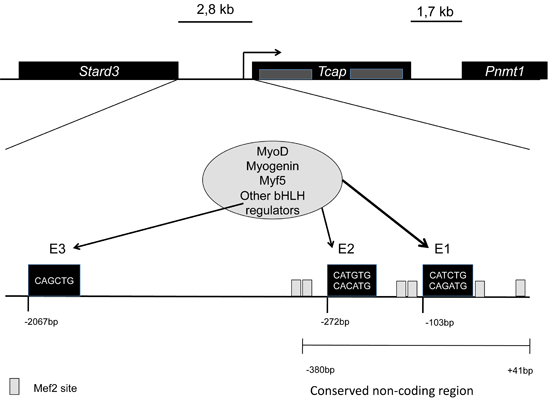Group:MUZIC:Telethonin
From Proteopedia

Telethonin
Also known as T-Cap or Titin Cap protein. It is a small protein of 19kDa, 167 amino acids. Predominantly expressed in striated muscle. It is a structural protein of the muscle; it is associated to the Z-disc in the sarcomere. It acts as link between titin and other proteins implicated in muscle structure and signalling.
Gene regulation and expressionIt is encoded by the Tcap gene, in mice (Mus musculus) and humans (Homo sapiens). In mice it is located in chromosome 11, in humans in the long arm of chromosome 17. Tcap is encoded by two exons, and has non-conserved intragenic sequences. The gene is flanked by two other genes, namely Stard3 upstream separated by 2,8kb, and Pnmt1 downstream separated by 1,7kb. It has three conserved E-box elements at -103bp (E1), -272bp (E2), and -2067bp (E3). For the full activation of the gene the regulation of E1 is highly important. MyoD plays an important role in this regulation all through development, while myogenin mainly during late differentiation into myoblasts. [1] At the transcriptional level it is thought that there is only one isoform of Tcap, and it is one of the most abundant transcripts in skeletal muscle [2]. It does not have different levels of expression in different types of skeletal muscle; levels of expression of Tcap are lower in neonatal compared to adult striated muscle. The transcript is accumulated in a linear pattern similar to that of the myosin heavy chain [3]. In these same studies it was reported that denervation leads to decrease in the expression of Tcap, suggesting that locomotor activity is a potential regulator of its maintenance. Tcap proteinTelethonin protein is found mostly in skeletal and cardiac muscle. It is one of the major components of the sarcomere, it is localized to the Z-disc. Studies on telethonin structure by Zou et al. [4] report that it is made up of five stranded antiparallel β-sheets extended by two wing-shaped β-hairpin motifs (A-B, C-D). These two motifs are related by an approximate two-fold symmetry, which generates an almost perfect palindromic arrangement. The structure of telethonin was determined using X-ray crystallography [5],[6] . The shape and architecture of the complex of titin/telethonin was studied by small-angle- X-ray scattering (SAXS) and then compared to the crystallographic models. They also used in-vitro experiments to follow the formation of the complex in non-myogenic Cos1 cells, in order to understand if the assemblage is possible [7] This symmetry of telethonin permits its interaction with titin. Both are assembled in an antiparallel sandwich in a 2:1 (titin:telethonin). Titin N-terminal domains Z1 and Z2 interact with the N-terminal region of telethonin (residues 1-53). Telethonin mediates in the antiparallel assembly of the two Z1Z2domains. In early differentiating myocytes titin C-terminal and telethonin co-localize and titin kinase is close to telethonin C-terminal, and it is phosphorylated. This phosphorylation is involved in the reorganization of the cytoskeleton during myofibrillogenesis. [8] This co-localization is not seen in adult myofibrils, titin kinase is reported to localize in the M-band [9]; It was also informed that telethonin interacts with other proteins including: Potassium channel subunit minK/isk [10], ankyrin1, and Z-disc proteins FATZ, Calsarcin-3 [11], [12], Ankrd2,[13] and MLP. [14] MLP-Telethonin complex is part of the mechanical stretch sensor machinery in cardiac muscle. The binding site of telethonin and MLP is adjacent to the titing binding domain. This interaction is critical for maintaining normal cardiac function. MLP is required for the stabilization of telethonin-titin complex, this mechanism is not clear yet. The interaction between Ankrd2 and telethonin has been proposed as a sensor of muscle stress/stretch and a starting point for the transmission of the mechanical signal to the nucleus regulating gene expression. [15] Telethonin is also involved in signalling processes that regulate muscle development. A feed back loop is formed with MRFs (MyoD, myogenin, Myf5) regulating Tcap gene expression; telethonin interacts with myostatin, inhibiting it. So it regulates MyoD through the Myostatin – Smad3 pathway. [16]. Image:Telethonin Myostatin.jpg Pathologies associated to telethoninDifferent mutations in telethonin have been associated to several myopathies. Mutations can lead to limb-girdle muscular dystrophy type 2G (LGMD2G) [17], to hypertrophic cardiopathy., [18], and dilated cardiomyopathy. A frameshift mutation in the Tcap gene leads to a deletion of the telethonin C-terminal region, losing the site which can be phosphorylated, for example by titin kinase [19], as was observed in a few brazilian families. Defects in the MLP-Tcap association are linked to human dilated cardiomyopathy and heart failure (Knöll 2002). Mutations that affect ability of MLP to interact with telethonin result in the loss of telethonin binding, facilitating its mislocalization from the complex with titin, leading to defects in the Z-disc and progression of dilated cardiomyopathy. Knöll et al. conclude that genetic mutations causing a incorrect interaction of telethonin with MLP can lead to a development of human dilated cardiomyopathy through modifications in the conformation and function of titin. It was reported that in 10 cases of neurogenic atrophy there was a decreased staining for telethonin in type II fibers, and in early stages of fiber atrophy, [20] indicating a selective downregulation of telethonin. These observations can be related to in vivo studies done in rats, in which after short term denervation (two days), Tcap transcript is reduced by about 50% in skeletal muscle. [21].
References
| ||||||||||||


